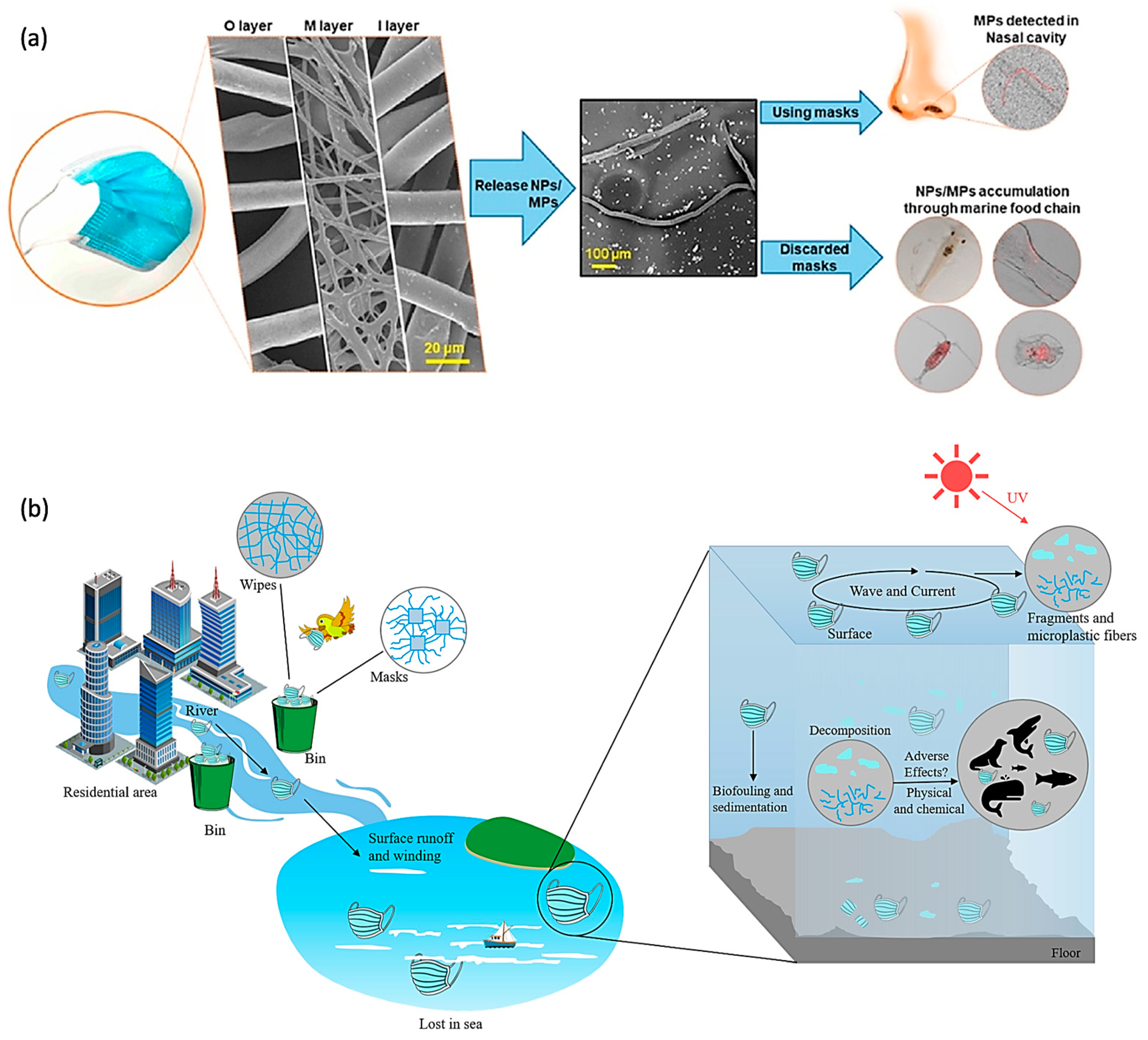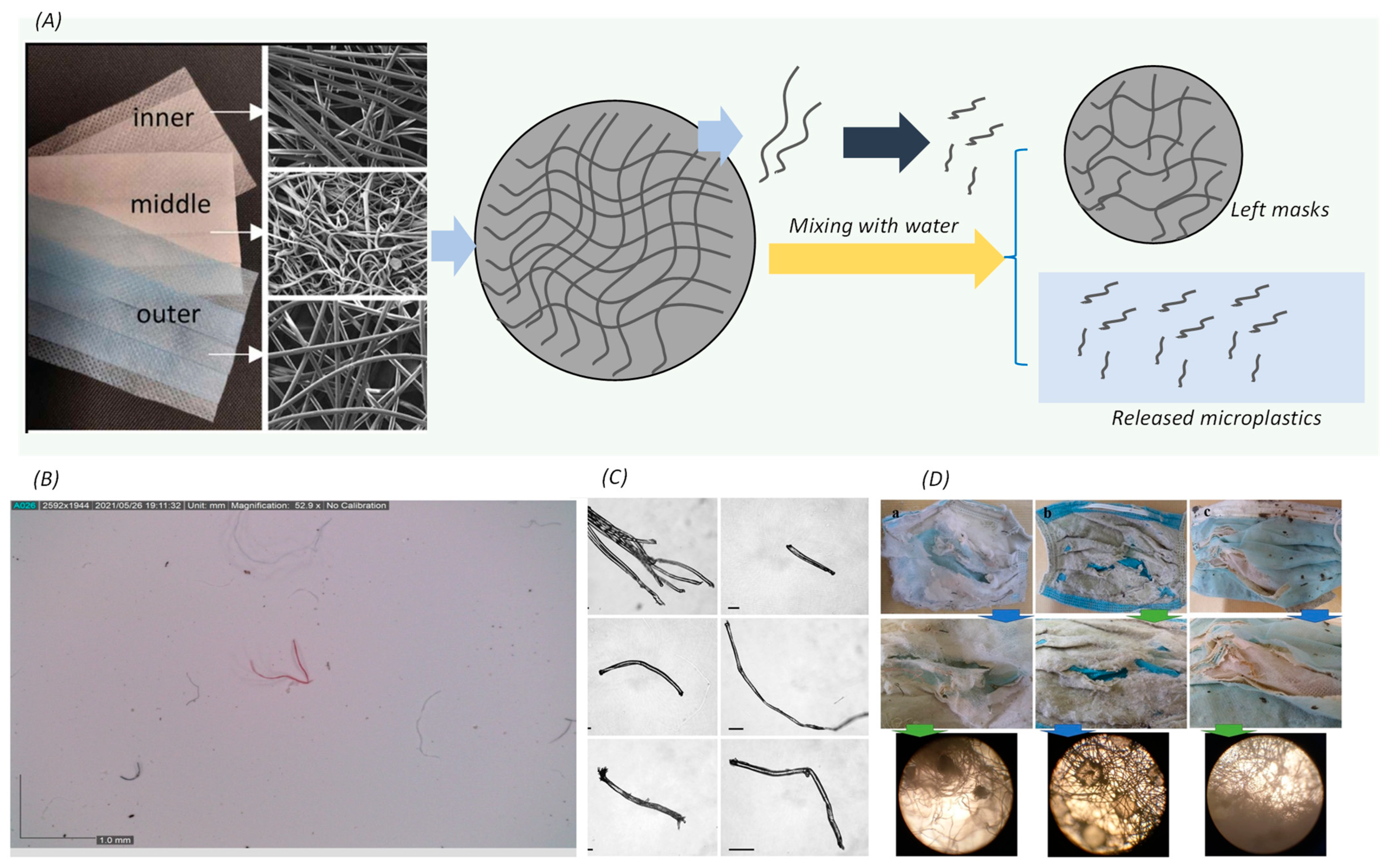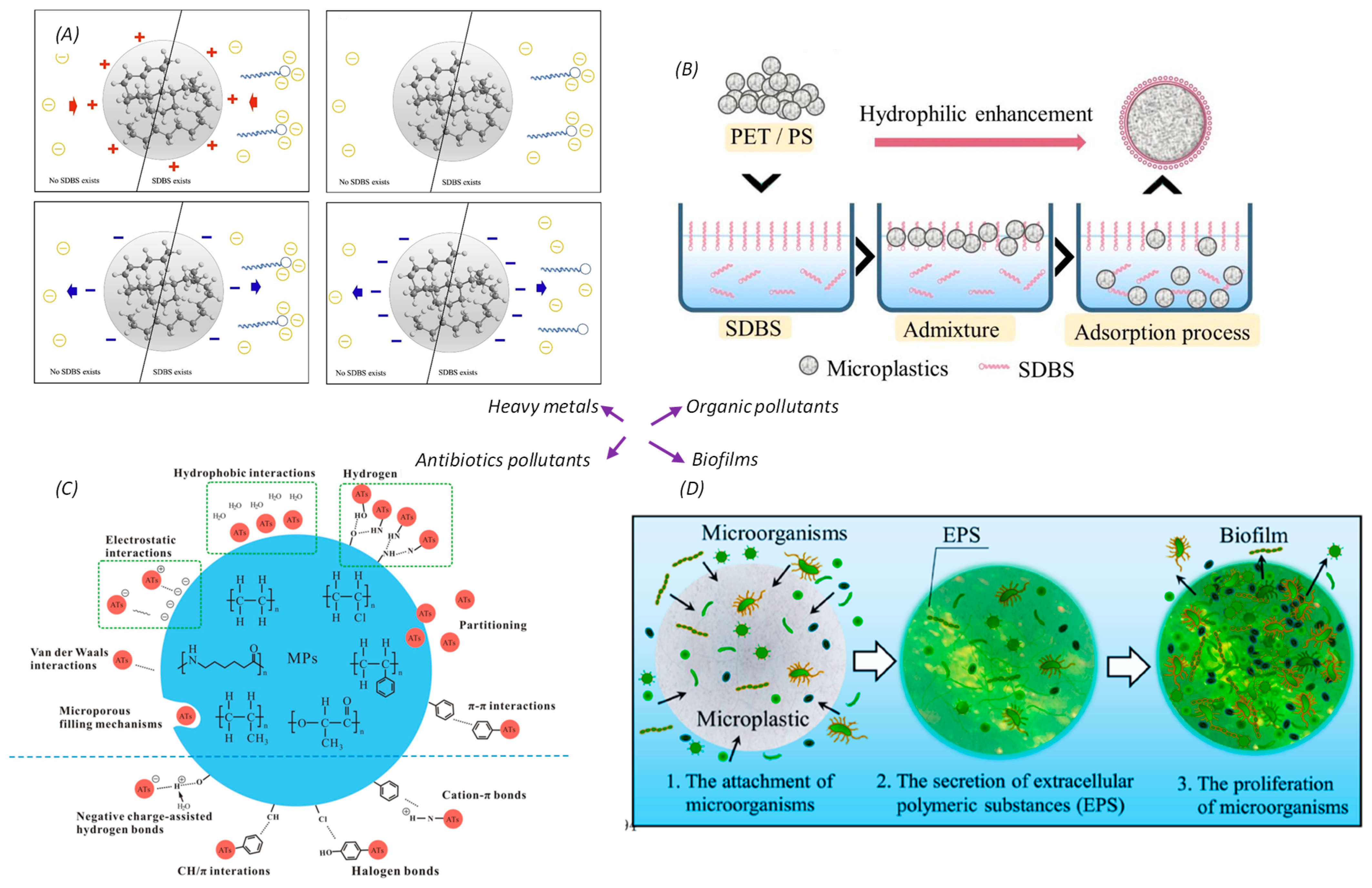The Fate of Microplastics, Derived from Disposable Masks, in Natural Aquatic Environments
Abstract
:1. Introduction
2. Quantity of Microplastics Derived from the Masks into the Water Environment
3. The Morphology of Microplastics Derived from Face Masks
4. Potential Interactions between the Microplastics (from Masks) and Other Pollutants
5. Challenges for Control of Microplastic Release from Personal Protective Equipment (PPE)
6. Conclusions
- (1)
- The amount of microplastics released from used face masks into water can be affected by multiple factors, such as test conditions, water quality, and degree of use, etc. The average amount of microplastics released from the masks ranged from 47 to more than 10,000 pieces per day for each mask under different environmental conditions. Furthermore, microplastic pollutants were mainly present in the form of polymeric fibers, with some finer particles. Within aquatic environments, the chemical bonds of the plastic fibers are also destroyed by the force of water flow, resulting in the generation of smaller fiber microplastics.
- (2)
- The dominant interface forces between the microplastics and other pollutants in an aqueous environment mainly involve hydrophobic interactions, electrostatic interactions as well as hydrogen bonding. To some extent, the shape of the fiber microplastics, released from face masks also tends to be different from the round microplastics commonly observed in the natural environment. However, the possible contact force between the pollutants and the microplastics largely remains as hydrophobic and electrostatic interactions. Thus, the fiber microplastics released from used face masks would have a tendency to adsorb other pollutants including heavy metals, organic pollutants or even biofilms.
- (3)
- In anticipation of forthcoming issues related to microplastic pollution arising from PPE, it is imperative to identify the primary sources and pathways through which microplastics from PPE enter the natural environment. Utilizing methods such as material flow analysis or more precise analytical routes is essential for gaining a comprehensive understanding of the flow of microplastics. Additionally, conducting thorough research on the intricate interface interactions between the plastic particles released from PPE and pollutants is crucial. This research aims to predict the potential risks posed to both ecosystems and human health, thereby enhancing our ability to proactively address and mitigate the impacts of microplastic pollution. Based on a systematic analysis of the origin, entire process, and interface interactions of plastic particles (from PPE) in natural environment, it is crucial to facilitate the optimal selection of relevant management or technological approaches for the effective control and treatment of microplastics.
Author Contributions
Funding
Institutional Review Board Statement
Informed Consent Statement
Data Availability Statement
Conflicts of Interest
References
- Patrício Silva, A.L.; Prata, J.C.; Walker, T.R.; Duarte, A.C.; Ouyang, W.; Barcelò, D.; Rocha-Santos, T. Increased plastic pollution due to COVID-19 pandemic: Challenges and recommendations. Chem. Eng. J. 2021, 405, 126683. [Google Scholar] [CrossRef] [PubMed]
- Alamdari, S.; Mirzaee, O.; Nasiri Jahroodi, F.; Jafar Tafreshi, M.; Sasani Ghamsari, M.; Salmani Shik, S.; Majles Ara, M.H.; Lee, K.Y.; Park, H.H. Green synthesis of multifunctional ZnO/chitosan nanocomposite film using wild Mentha pulegium extract for packaging applications. Surf. Interfaces 2022, 34, 102349. [Google Scholar] [CrossRef] [PubMed]
- Qiu, Z.; Wang, Y.; Li, C.; Yuan, X.; Zhu, B.; Liu, J. Interfacial strengthening of carbon fiber/epoxy composites through a sulfonated high-epoxy-value sizing agent. Surf. Interfaces 2023, 36, 102394. [Google Scholar] [CrossRef]
- Organisation for Economic Co-operation Development. The Face Mask Global Value Chain in the COVID-19 Outbreak: Evidence and Policy Lessons; OECD Publishing: Paris, France, 2020. [Google Scholar]
- Prata, J.C.; Patrício Silva, A.L.; Walker, T.R.; Duarte, A.C.; Rocha-Santos, T. COVID-19 Pandemic Repercussions on the Use and Management of Plastics. Environ. Sci. Technol. 2020, 54, 7760–7765. [Google Scholar] [CrossRef]
- Shukla, S.; Khan, R.; Saxena, A.; Sekar, S. Microplastics from face masks: A potential hazard post Covid-19 pandemic. Chemosphere. 2022, 302, 134805. [Google Scholar] [CrossRef] [PubMed]
- Ammendolia, J.; Saturno, J.; Brooks, A.L.; Jacobs, S.; Jambeck, J.R. An emerging source of plastic pollution: Environmental presence of plastic personal protective equipment (PPE) debris related to COVID-19 in a metropolitan city. Environ. Pollut. 2021, 269, 116160. [Google Scholar] [CrossRef] [PubMed]
- Adyel, T.M. Accumulation of plastic waste during COVID-19. Sci. N. Y. 2020, 369, 1314–1315. [Google Scholar] [CrossRef]
- Khoo, K.S.; Ho, L.Y.; Lim, H.R.; Leong, H.Y.; Chew, K.W. Plastic waste associated with the COVID-19 pandemic: Crisis or opportunity? J. Hazard. Mater. 2021, 417, 126108. [Google Scholar] [CrossRef]
- Torres-Agullo, A.; Karanasiou, A.; Moreno, T.; Lacorte, S. Overview on the occurrence of microplastics in air and implications from the use of face masks during the COVID-19 pandemic. Sci. Total Environ. 2021, 800, 149555. [Google Scholar] [CrossRef]
- Lin, L.; Yuan, B.; Hong, H.; Li, H.; He, L.; Lu, H.; Liu, J.; Yan, C. Post COVID-19 pandemic: Disposable face masks as a potential vector of antibiotics in freshwater and seawater. Sci. Total Environ. 2022, 820, 153049. [Google Scholar] [CrossRef]
- Aragaw, T.A. Surgical face masks as a potential source for microplastic pollution in the COVID-19 scenario. Mar. Pollut. Bull. 2020, 159, 111517. [Google Scholar] [CrossRef] [PubMed]
- Shruti, V.C.; Pérez-Guevara, F.; Elizalde-Martínez, I.; Kutralam-Muniasamy, G. Reusable masks for COVID-19: A missing piece of the microplastic problem during the global health crisis. Mar. Pollut. Bull. 2021, 161, 111777. [Google Scholar] [CrossRef] [PubMed]
- Wan, H.; Wang, J.; Sheng, X.; Yan, J.; Zhang, W.; Xu, Y. Removal of Polystyrene Microplastics from Aqueous Solution Using the Metal–Organic Framework Material of ZIF-67. Toxics 2022, 10, 70. [Google Scholar] [CrossRef] [PubMed]
- Zhang, W.; Zhang, L.; Hua, T.; Li, Y.; Zhou, X.; Wang, W.; You, Z.; Wang, H.; Li, M. The mechanism for adsorption of Cr(VI) ions by PE microplastics in ternary system of natural water environment. Environ. Pollut. 2020, 257, 113440. [Google Scholar] [CrossRef] [PubMed]
- Qiu, X.; Ma, S.; Zhang, J.; Fang, L.; Guo, X.; Zhu, L. Dissolved Organic Matter Promotes the Aging Process of Polystyrene Microplastics under Dark and Ultraviolet Light Conditions: The Crucial Role of Reactive Oxygen Species. Environ. Sci. Technol. 2022, 56, 10149–10160. [Google Scholar] [CrossRef] [PubMed]
- Wang, J.; Guo, X.; Xue, J. Biofilm-Developed Microplastics as Vectors of Pollutants in Aquatic Environments. Environ. Sci. Technol. 2021, 55, 12780–12790. [Google Scholar] [CrossRef] [PubMed]
- Zhang, L.; Li, Y.; Wang, W.; Zhang, W.; Zuo, Q.; Abdelkader, A.; Xi, K.; Heynderickx, P.M.; Kim, K.-H. The potential of microplastics as adsorbents of sodium dodecyl benzene sulfonate and chromium in an aqueous environment. Environ. Res. 2021, 197, 111057. [Google Scholar] [CrossRef]
- Sheng, X.; Wang, J.; Zhang, W.; Zuo, Q. The Potential for PE Microplastics to Affect the Removal of Carbamazepine Medical Pollutants from Aqueous Environments by Multiwalled Carbon Nanotubes. Toxics 2021, 9, 139. [Google Scholar] [CrossRef]
- Li, L.; Zhao, X.; Li, Z.; Song, K. COVID-19: Performance study of microplastic inhalation risk posed by wearing masks. J. Hazard. Mater. 2021, 411, 124955. [Google Scholar] [CrossRef]
- Hu, T.; Shen, M.; Tang, W. Wet wipes and disposable surgical masks are becoming new sources of fiber microplastic pollution during global COVID-19. Environ. Sci. Pollut. Res. 2022, 29, 284–292. [Google Scholar] [CrossRef]
- Ma, J.; Chen, F.; Xu, H.; Jiang, H.; Liu, J.; Li, P.; Chen, C.C.; Pan, K. Face masks as a source of nanoplastics and microplastics in the environment: Quantification; characterization; and potential for bioaccumulation. Environ. Pollut. 2021, 288, 117748. [Google Scholar] [CrossRef] [PubMed]
- Kutralam-Muniasamy, G.; Pérez-Guevara, F.; Shruti, V.C. A critical synthesis of current peer-reviewed literature on the environmental and human health impacts of COVID-19 PPE litter: New findings and next steps. J. Hazard. Mater. 2022, 422, 126945. [Google Scholar] [CrossRef] [PubMed]
- Chen, X.; Chen, X.; Liu, Q.; Zhao, Q.; Xiong, X.; Wu, C. Used disposable face masks are significant sources of microplastics to environment. Environ. Pollut. 2021, 285, 117485. [Google Scholar] [CrossRef]
- Liang, H.; Ji, Y.; Ge, W.; Wu, J.; Song, N.; Yin, Z.; Chai, C. Release kinetics of microplastics from disposable face masks into the aqueous environment. Sci. Total Environ. 2022, 816, 151650. [Google Scholar] [CrossRef] [PubMed]
- Shen, M.; Zeng, Z.; Song, B.; Yi, H.; Hu, T.; Zhang, Y.; Zeng, G.; Xiao, R. Neglected microplastics pollution in global COVID-19: Disposable surgical masks. Sci. Total Environ. 2021, 790, 148130. [Google Scholar] [CrossRef] [PubMed]
- Saliu, F.; Veronelli, M.; Raguso, C.; Barana, D.; Galli, P.; Lasagni, M. The release process of microfibers: From surgical face masks into the marine environment. Environ. Adv. 2021, 4, 100042. [Google Scholar] [CrossRef]
- Dissanayake, J.; Torres-Quiroz, C.; Mahato, J.; Park, J. Facemasks: A Looming Microplastic Crisis. Int. J. Environ. Res. Public Health 2021, 18, 1052. [Google Scholar] [CrossRef]
- Jiang, H.; Su, J.; Zhang, Y.; Bian, K.; Wang, Z.; Wang, H.; Wang, C. Insight into the microplastics release from disposable face mask: Simulated environment and removal strategy. Chemosphere 2022, 309, 136748. [Google Scholar] [CrossRef]
- Dybas, C.L. Silent Scourge: Microplastics in Water, Food, and Air: Scientists focus on the human health effects of ubiquitous plastics. BioScience 2020, 70, 1048–1055. [Google Scholar] [CrossRef]
- Cordova, M.R.; Nurhati, I.S.; Riani, E.; Nurhasanah; Iswari, M.Y. Unprecedented plastic-made personal protective equipment (PPE) debris in river outlets into Jakarta Bay during COVID-19 pandemic. Chemosphere 2021, 268, 129360. [Google Scholar] [CrossRef]
- Akhbarizadeh, R.; Dobaradaran, S.; Nabipour, I.; Tangestani, M.; Abedi, D.; Javanfekr, F.; Jeddi, F.; Zendehboodi, A. Abandoned Covid-19 personal protective equipment along the Bushehr shores, the Persian Gulf: An emerging source of secondary microplastics in coastlines. Mar. Pollut. Bull. 2021, 168, 112386. [Google Scholar] [CrossRef] [PubMed]
- Sullivan, G.L.; Delgado-Gallardo, J.; Watson, T.M.; Sarp, S. An investigation into the leaching of micro and nano particles and chemical pollutants from disposable face masks - linked to the COVID-19 pandemic. Water Res. 2021, 196, 117033. [Google Scholar] [CrossRef] [PubMed]
- Morgana, S.; Casentini, B.; Amalfitano, S. Uncovering the release of micro/nanoplastics from disposable face masks at times of COVID-19. J. Hazard. Mater. 2021, 419, 126507. [Google Scholar] [CrossRef] [PubMed]
- Wang, Z.; An, C.; Chen, X.; Lee, K.; Zhang, B.; Feng, Q. Disposable masks release microplastics to the aqueous environment with exacerbation by natural weathering. J. Hazard. Mater. 2021, 417, 126036. [Google Scholar] [CrossRef] [PubMed]
- Akber Abbasi, S.A.; Khalil, A.B.; Arslan, M. Extensive use of face masks during COVID-19 pandemic: (micro-)plastic pollution and potential health concerns in the Arabian Peninsula. Saudi J. Biol. Sci. 2020, 27, 3181–3186. [Google Scholar] [CrossRef] [PubMed]
- Wu, P.; Zhang, H.; Singh, N.; Tang, Y.; Cai, Z. Intertidal zone effects on Occurrence, fate and potential risks of microplastics with perspectives under COVID-19 pandemic. Chem. Eng. J. 2022, 429, 132351. [Google Scholar] [CrossRef]
- Aslanzadeh, S.; Kish, M.H. Photo-oxidation of polypropylene fibers exposed to short wavelength UV radiations. Fibers Polym. 2010, 11, 710–718. [Google Scholar] [CrossRef]
- Aslanzadeh, S.; Kish, M.H. Photodegradation of polypropylene thermal bonded non-woven fabric. Polym. Degrad. Stab. 2005, 90, 461–470. [Google Scholar] [CrossRef]
- Kokalj, A.J.; Dolar, A.; Drobne, D.; Škrlep, L.; Škapin, A.S.; Marolt, G.; Nagode, A.; van Gestel, C.A.M. Effects of microplastics from disposable medical masks on terrestrial invertebrates. J. Hazard. Mater. 2022, 438, 129440. [Google Scholar] [CrossRef]
- Guo, X.; Wang, J. The chemical behaviors of microplastics in marine environment: A review. Mar. Pollut. Bull. 2019, 142, 1–14. [Google Scholar] [CrossRef]
- Wang, Y.; Yang, Y.; Liu, X.; Zhao, J.; Liu, R.; Xing, B. Interaction of Microplastics with Antibiotics in Aquatic Environment: Distribution, Adsorption, and Toxicity. Environ. Sci. Technol. 2021, 55, 15579–15595. [Google Scholar] [CrossRef] [PubMed]
- Fu, L.; Li, J.; Wang, G.; Luan, Y.; Dai, W. Adsorption behavior of organic pollutants on microplastics. Ecotoxicol. Environ. Saf. 2021, 217, 112207. [Google Scholar] [CrossRef]
- Wang, F.; Wong, C.S.; Chen, D.; Lu, X.; Wang, F.; Zeng, E.Y. Interaction of toxic chemicals with microplastics: A critical review. Water Res. 2018, 139, 208–219. [Google Scholar] [CrossRef]
- Olatayo, K.I.; Mativenga, P.T.; Marnewick, A.L. COVID-19 PPE plastic material flows and waste management: Quantification and implications for South Africa. Sci. Total Environ. 2021, 790, 148190. [Google Scholar] [CrossRef]
- Schwarz, A.; Lensen, S.; Langeveld, E.; Parker, L.; Urbanus, J.H. Plastics in the global environment assessed through material flow analysis, degradation and environmental transportation. Sci. Total Environ. 2023, 875, 162644. [Google Scholar] [CrossRef] [PubMed]
- Beebe, N.H.F. A Complete Bibliography of Publications in IMA Journal of Applied Mathematics. Algorithms 2019, 10, 1052. [Google Scholar]
- Mason, V.G.; Skov, M.W.; Hiddink, J.G.; Walton, M. Microplastics alter multiple biological processes of marine benthic fauna. Sci. Total Environ. 2022, 845, 157362. [Google Scholar] [CrossRef]
- Zhang, S.; Wang, J.; Liu, X.; Qu, F.; Wang, X.; Wang, X.; Li, Y.; Sun, Y. Microplastics in the environment: A review of analytical methods, distribution, and biological effects. TrAC Trends Anal. Chem. 2019, 111, 62–72. [Google Scholar] [CrossRef]
- Zhang, H.; Quan, H.; Zhou, S.; Sun, L.; Lu, H. Enhanced performance and electron transfer of sulfur-mediated biological process under polyethylene terephthalate microplastics exposure. Water Res. 2022, 223, 119038. [Google Scholar] [CrossRef]
- Huan, H.; Wang, S.; Ji, B.; Zhang, Y.; Pi, K.; Shi, Y. Adaptation responses of microalgal-bacterial granular sludge to polystyrene microplastic particles in municipal wastewater. Environ. Sci. Pollut. Res. 2022, 29, 59965–59973. [Google Scholar]




| Index | Type of Mask | Microplastics Release/Piece·Day−1 | Microplastics Morphology | Ref. |
|---|---|---|---|---|
| 1 | Disposable face mask | 1246.62 ± 403.50 | fiber | [24] |
| 2 | N95 Mask | 801 ± 71–2667 ± 97 | fiber | [25] |
| medical surgical mask | 1136 ± 87–2343 ± 168 | |||
| Normal medical mask | 1034 ± 119–2547 ± 185 | |||
| 3 | Disposable surgical mask | 116,600 (in water) 168,800 (in detergent) 147,000 (in alcohol) | fiber | [26] |
| 4 | Surgical face mask | 173,000 (in seawater) | fiber | [27] |
| 5 | medical surface mask | 1447 ± 218 | Fiber/particle | [29] |
| N95 mask | 1339 ± 166 | |||
| activated carbon mask | 1600 ± 237 |
Disclaimer/Publisher’s Note: The statements, opinions and data contained in all publications are solely those of the individual author(s) and contributor(s) and not of MDPI and/or the editor(s). MDPI and/or the editor(s) disclaim responsibility for any injury to people or property resulting from any ideas, methods, instructions or products referred to in the content. |
© 2024 by the authors. Licensee MDPI, Basel, Switzerland. This article is an open access article distributed under the terms and conditions of the Creative Commons Attribution (CC BY) license (https://creativecommons.org/licenses/by/4.0/).
Share and Cite
Zhang, W.; Chai, S.; Duan, C.; Sun, X.; Zuo, Q.; Gong, L. The Fate of Microplastics, Derived from Disposable Masks, in Natural Aquatic Environments. Toxics 2024, 12, 61. https://doi.org/10.3390/toxics12010061
Zhang W, Chai S, Duan C, Sun X, Zuo Q, Gong L. The Fate of Microplastics, Derived from Disposable Masks, in Natural Aquatic Environments. Toxics. 2024; 12(1):61. https://doi.org/10.3390/toxics12010061
Chicago/Turabian StyleZhang, Wei, Senyou Chai, Changhui Duan, Xueliang Sun, Qiting Zuo, and Lin Gong. 2024. "The Fate of Microplastics, Derived from Disposable Masks, in Natural Aquatic Environments" Toxics 12, no. 1: 61. https://doi.org/10.3390/toxics12010061





